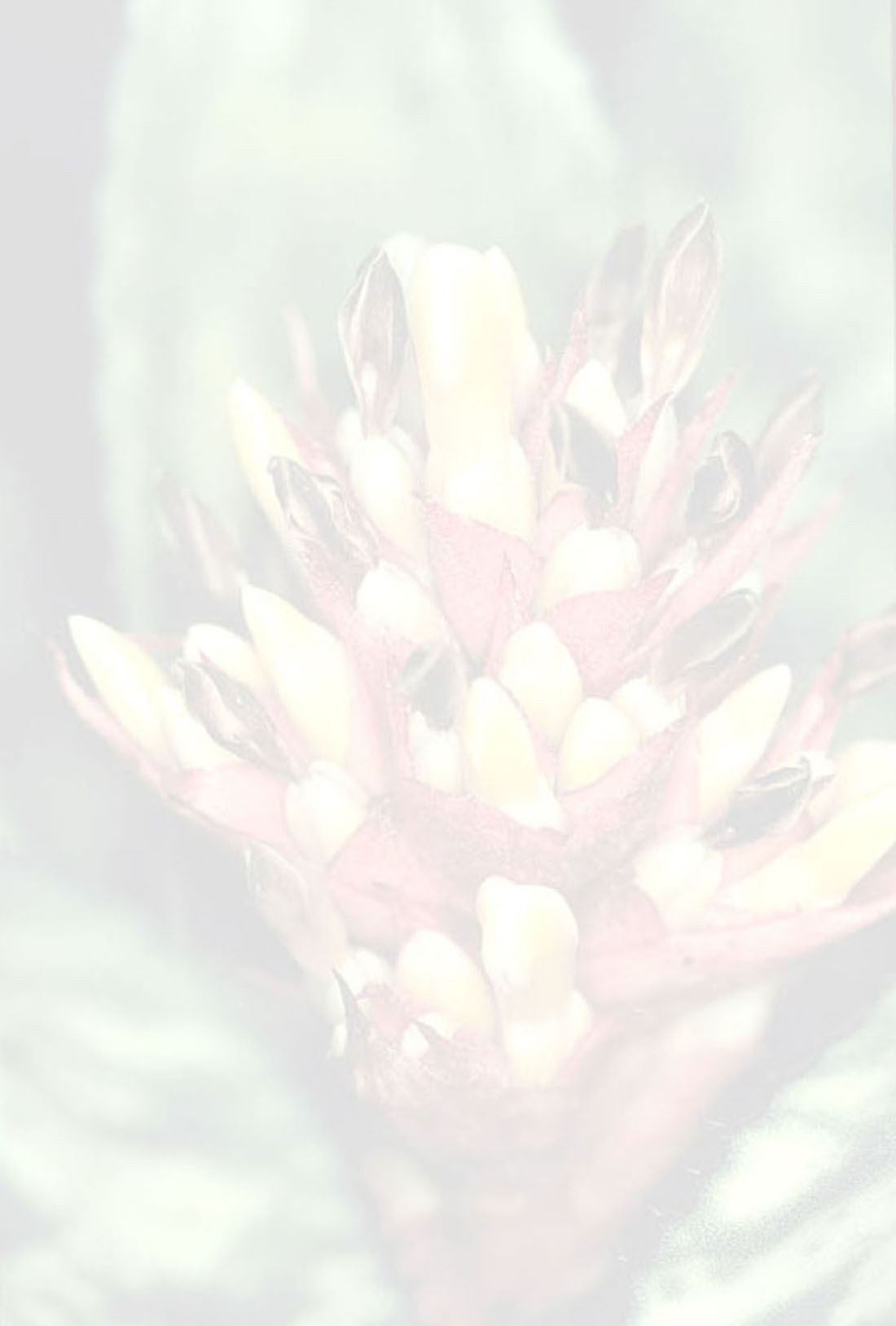Aechmea weilbachii F.Didr.
Literature references:
*move your mouse pointer over the page numbers to see comment
Comments:
- Key to the identification of varieties and forms of A. weilbachii:
1- Sepals green or lilac towards the apex, petals obtuse, purple var. weilbachii
2- Leaves green
3- Inflorescence erect
4- Sepals lilac, petals pale purple var. weilbachii forma weilbachii
4- Sepals green, petals dark purple var. weilbachii forma viridisepala
3-lnflorescence pendent var. weilbachii forma pendula
2- Leaves purple var. weilbachii forma leodiensis
1- Sepals white towards the apex, apex with a tiny dark purple spot, petals widely acute and apiculate, entirely white except for a dark purple tip var. albipetala p. Butcher
- Notes from Herbarium Bradeanum, IV Edmundo Pereira and Elton M.C. Leme in J. Brom. Soc. 37(3): 123-4. 1987
Typical of the Brazilian Atlantic forest, the Aechmea weilbachii Didrichsen may be found in the states of Rio de Janeiro and Espirito Santo. As an epiphyte in places protected from direct sunlight, it inhabits the middle height of the trunks of the trees which form the vegetation of the mountainside at altitudes up to approximately 1,000 meters. In the State of Rio de Janeiro, it can be seen frequently in the Tijuca National Park (where the type of the species was collected), and in the National Park of Serra dos Orgaos.
From variations observed in small populations, the variety leodiensis Andre (1887) and the form pendula Reitz (1975) were created. The former, very little known in nature, was collected in 1974 by Raulino Reitz in the county of Mage at a low altitude. That fact represents a very important datum as to the geographical distribution of this variety. As to the f. pendula, which can be distinguished easily from the typical form by the pendulous inflorescence, we concur with the status forma adopted by its author because it gives a better picture of these variations of populational groups. We note that the occurrence of the latter is limited to the area where the typical A. weilbachii grows.
This being so, following the example of Reitz and with the intention of putting the group in better order, we propose a new combination, besides a new form, as follows:
A. Aechmea weilbachii Didr. forma leodiensis (Andre) Pereira & Leme, comb. nov.
Basionym: Aechmea weilbachii Didr. var. leodiensis Andre, Revue Hort. 59:31; 1887. Type. Paris Hortus s n (P? n v), Brazil. Supplementary collection: P.R. Reitz 7663 (RBR n v), Mage, Rio de Janeiro, Brazil, July 20, 1974.
B. Aechmea weilbachii Didr. forma pendula Reitz, Bromelia 1 (Sellowia no. 26):33, pl. 3; 1975. Type. P.R. Reitz 7730 (RBR n v), Poco Verde, Mage, Orgaos Mountains, Rio de Janeiro, Brazil, Dec. 24, 1974.
Synonym: Aechmea weilbachii Didr. var. pendula Pereira & Moutinho, Bradea 3(27): 214, pl. 6; 1981. Type. D. Sucre s n (HB), Rio de Janeiro State, Brazil, June 1981. Supplementary collection: R. Braga & P.I.S. Braga 929 (RB, HBR, US, R, GUA), Rio-Petropolis road, Rio de Janeiro, Brazil, Aug. 10, 1968.
C. Aechmea weilbachii Didr. forma viridisepala Pereira & Leme nov. forma.
Differt a formis adhuc cognitis scapo erecto, sepalis plene viridibus et petalis atropurpureis. Type. E.M. C. Leme 552 (holotype, HB, isotype, RB), epiphytic of low elevation, near Centro de Primatologia do Rio de Janeiro/PEEMA, boundary between Cachoeira de Macacu and Mage, Rio de Janeiro, Brazil, July 9, 1984. It differs from the known forms by the erect scape, green sepals, and dark purple petals.
Supplementary collection: ibid. E.M. C. Leme 652 (RB), 1985; R. Braga 18 & P.I.S. Braga 928 (RB, US), Rio-Friburgo road, Rio de Janeiro, Brazil, 1968.
D. Aechmea weilbachii Didr. forma weilbachii, Ann. Sci. Nat. Bot. IV.2:375; 1854. Type. Didrichsen s n (C n v), Corcovado, National Park of Tijuca, Rio de Janeiro, Brazil, 1847.
Supplementary collection: G. Martinelli 8469 & H. C. de Lima (RB), Paz. Capim Melado, Silva Jardim, Seser. Biol. de Poco das Antas, Rio de Janeiro, Brazil, 1983; G. Martinelli 8513 (RB), near Quitandinha, Petropolis, May 30, 1982; J. G. Kuhlmann s n (RB), Botanical Garden of Rio de Janeiro, City of Rio de Janeiro, Brazil, May 26, 1942; ibid. G. Martinelli 4594 (RB), June 16, 1978. —See Pereira & Leme 1987 p. 123-124

